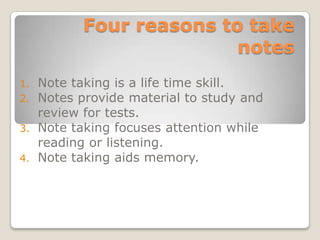
Cornell notes
- 1. Four reasons to take notes 1. Note taking is a life time skill. 2. Notes provide material to study and review for tests. 3. Note taking focuses attention while reading or listening. 4. Note taking aids memory.
- 2. Creating the Note Page Create a fold or divide 1/3 The final note page over on your sheet has four parts Note Header Details Summary
- 3. Header 1. Placement at top of page 2. Name, course, date, topic 3. Descriptive title
- 4. Main Ideas 1. Located in the left hand column. 2. Look for key words or phrases that sum up points made in a section or paragraph. 3. Usually at the very beginning or very end of a section or paragraph. 4. Relate to all of the supporting ideas.
- 5. Details/Support 1. Located in the right hand column. 2. Enter separate details/supporting ideas in point form beside related main ideas 3. Use abbreviations, short phrases, symbols, diagrams, sketches, etc.
- 6. Summary 1. Located in the bottom row. 2. Make a sentence in your own words that summarizes the information. 3. State what you have learned from the reading or lecture.
- 7. How to use notes 1. Cover up details. 2. Look only at the idea/questions and recite details aloud from memory. 3. Uncover details to check. 4. Repeat as necessary.
- 8. Example {Name}; {Class}; {Date} Topic: Cornell Note-taking Subject: Academic Listening/Reading Assignment 1 1. life time skill > org. learning reasons for 2. material to study & rev. 4 tests taking notes 3. helps focus attention while rdng/listng 4. provides reps, ??ing & summarizing >> aid long term memory how to study 1. cover up details from notes 2. look only at main ideas > recite details from memory > uncover details > check 3. repeat Summary: Note taking is an important skill in learning by summarizing and repeating important information and providing material to prepare for tests.
- 9. Evaluating Notetaking 0 1 2 3 Distinguishes Does not Barely meets Successfully Exceeds main ideas meet expectations meets expectations from support expectations expectations Summary Does not Barely meets Successfully Exceeds reflects intent meet expectations meets expectations and student expectations expectations learning Notes are Does not Barely meets Successfully Exceeds completed to meet expectations meets expectations some level of expectations expectations detail
